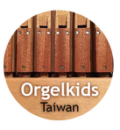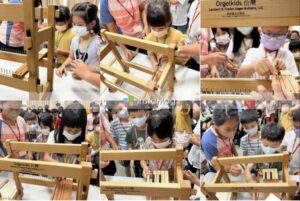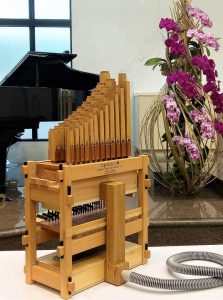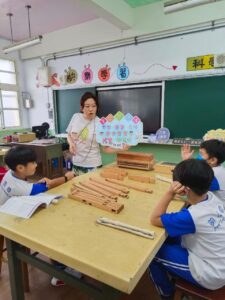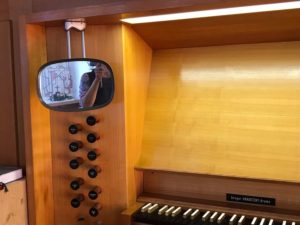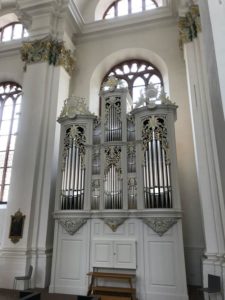Orgelkids China執行長蔣士挺(Justin Berg)「兒童管風琴教育專欄」【初因初音】。
『Aristide Cavaille-Coll』from the column【My First Sound】 by Justin Berg, the Executive Director of Orgelkids China. (In English below)
古典法國管風琴的腳鍵盤不但形狀獨特,音栓也很少。即使到了十八世紀末期,腳鍵盤也經常只有八呎和四呎的笛管,以及十二呎的燦爛簧管及六呎法國小喇叭音管(例如1783年François-Henri Clicquot在Souvigny修道院建造的管風琴,見音栓表)。或許你會覺得剛才提到的數字似乎有點奇怪:為什麼笛管是「正常」的八呎和四呎音高,簧管卻是十二呎和六呎音高呢?這就與另一個很有意思的特點有關了:古典法國管風琴的腳鍵盤往往還有一個有趣的設計,一般腳鍵盤都是和手鍵盤一樣排列的CDEFGAB,但是凡爾賽宮與Souvigny修道院的管風琴,最低原本應該是#C的位置,其實是更低八度的A音。這也印證了當時樂律並不是平均律,並不是所有調性都可以用來作曲的。D調,與A調被作曲家使用的頻率會更高一些,這也是建造者為什麼捨棄了#C而選擇了更為常用的低八度的A音。但只有簧管能演奏出腳鍵盤最低音的部分。因為簧管從較低的音高開始,它們的共鳴體(音管)就比較長,必須用比較大的數字來標識,因此會出現十二呎和六呎。腳鍵盤的簧管也很有力,能夠穿透齊奏的音量和織體,以便突顯出一段旋律,通常會是一段聖詠定旋律。
我們再提出古典法國管風琴值得注意的兩個特點:增風琴和回聲鍵盤。這兩個鍵盤都有特定的用途。增風琴通常會是第三個鍵盤,這個獨奏鍵盤只包含幾個音栓,它的音管也是位於架高的小型風廂上,就像主鍵盤的小號音管一樣。建造者也可以把這些音管設在外殼裡面,因為增風琴只有高聲部手鍵盤,從中央C或低幾個音開始。這個鍵盤通常只有兩、三個音栓,例如燦爛的簧片音管、雙簧管和小號,這就表示除了主鍵盤之外,還有第二組架高的小號音管。
這個時期的管風琴也包含一組回聲鍵盤,位於所有鍵盤中最高的位置(通常是第四個鍵盤,離管風琴家最遠)。這個鍵盤控制的一小群音管位於管風琴外殼的最底部,也就是在櫃子裡,音色非常寧靜,與其他的鍵盤形成動態的對比,因為主鍵盤(第二組鍵盤)很大聲、背風琴(第一組鍵盤)音量溫和,回聲鍵盤則音色輕柔。
上述的幾項特點——高調的簧管、深刻的基礎音栓組合,再加上腳鍵盤、增風琴和回聲鍵盤——由於卡發耶科爾獨特的創意和天才,在十九世紀都會出現全新的面貌。他重新運用法國古典管風琴所有的元素和特點,加以替換和重新想像,創造出極為新穎的法國交響式管風琴,我們會用下一篇文章探討他如何達成這項音樂上的革新。
你的朋友蔣士挺
〜Aristide Cavaille-Coll (part I) continued (3)〜
Aside from the shape of the pedal keys, the Pedale stops of the Classical French organs was typically few. Even instruments toward the end of the Eighteenth century often only had 8’ and 4’ Flûtes, as well as 12’ Trompette and 6’ Clarion (e.g. François-Henri Clicquot’s 1783 organ in Souvigny) in the pedal division. Perhaps you noticed something strange about the numbers in that previous sentence? Why are the flutes at ‘normal’ 8’ and 4’ pitches while the reeds are given at 12’ and 6’? This has to do with another interesting feature of the Classical French organ: the pedalboards often extended below C2, anywhere from a third (A1) to a fifth (F1), but only the reeds played in this lowest portion of the pedalboards, known as Ravalement. Because the reeds began from these lower notes, their resonators (pipe bodies) were longer and thus had to be measured using larger numbers, hence the 12’ and 6’ lengths. The reeds of the French pedal division were also forceful, able to penetrate the volume and texture of the full Plein Jeu in order to solo out a melody, usually a chant.
Of the remaining features of these Classical organs deserving of our attention, we will consider just two: the Récit and Echo divisions. Both of these keyboards enjoyed specialized uses. Usually the third manual, the Récit was a solo division containing just a few stops, the pipes of which also stood on a small mounted windchest, much like the Cornet of the Grand Orgue. It was possible for builders to position these pipes high inside the case because the Récit was only a treble manual, commencing from, or a few notes below middle C. Normally, this division had only two or three stops, such as a Trompette, Hautbois (oboe) and Cornet. This meant that there was a second mounted Cornet in addition to the one on the Grand Orgue!
By complete contrast, the organs of this era often included a manual called Echo, which sat the highest of all the keyboards (typically fourth, and thus furthest away from the organist). This keyboard controlled a small division of pipes that were positioned in the bottom of the organ case — in its chest, so to speak — and which sounded so quiet that it functioned as a kind of dynamic contrast with the other manuals: loud on the Grand Orgue (2nd manual), moderately loud on the Positif (1st manual), and soft on the Echo.
All of the above features — the brash reeds, the profound principle choruses, with the Pedale, Récit and Echo divisions — would take on a new life in the next century thanks to the extraordinary inventiveness of Aristide Cavaille-Coll. He reused, replaced and reimagined all of these components and features of the Classical organ to create something ultimately new, the French Symphonic Organ. In our next article, we’ll learn how he achieved this musical innovation.
Your Friend,
Justin
